A Guide to the Mountain Ranges of the World
Explore the major mountain ranges of the world from the Himalayas to the Andes. Our guide covers their formation, unique ecosystems, and global importance.
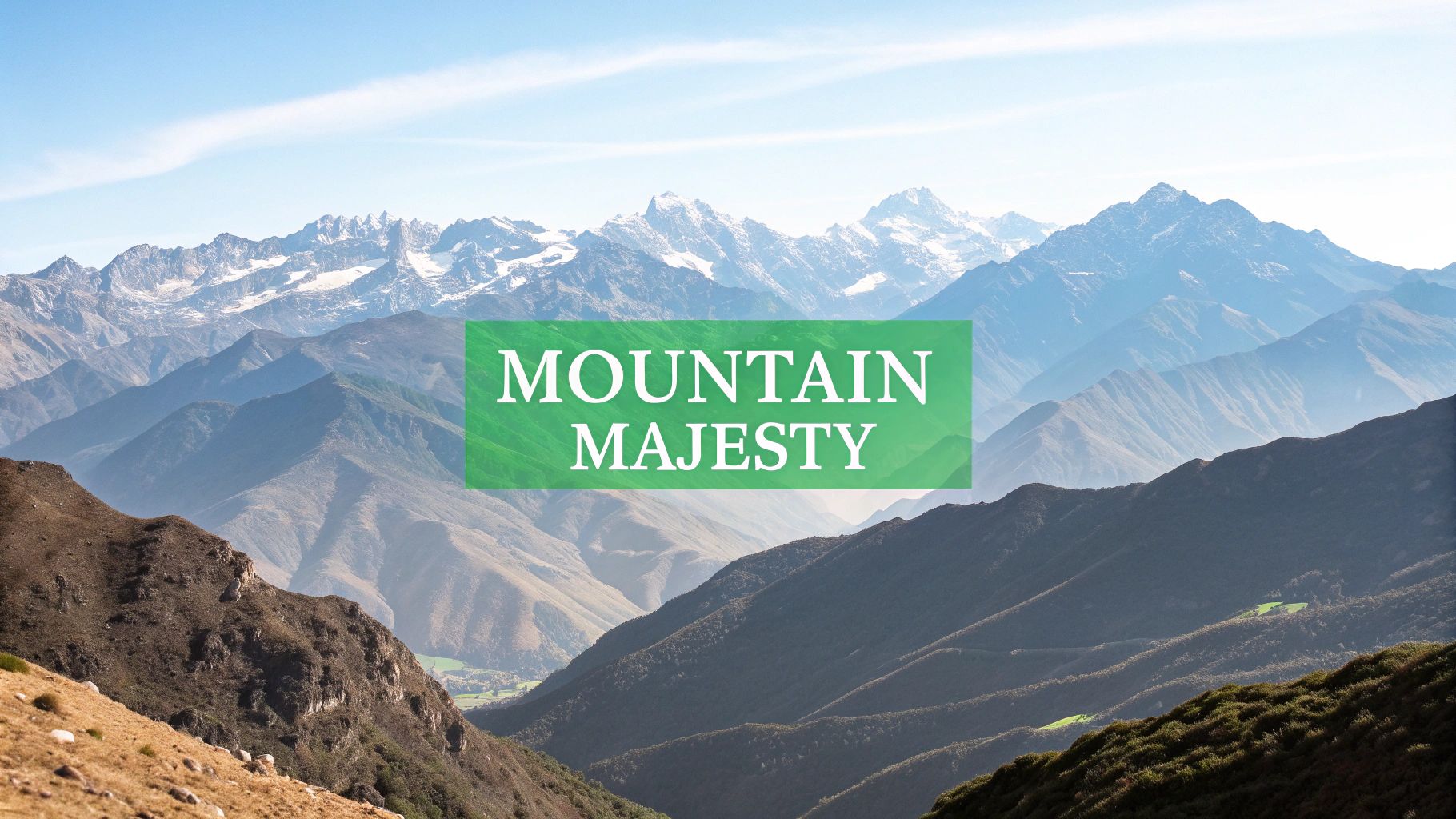
Picture yourself standing before a colossal structure, one carved from the very rock of the Earth. These natural titans don't just scrape the sky; they serve as borders, dictate weather patterns, and cradle entire civilizations. The great mountain ranges of the world are far more than just points on a map—they are the planet's backbone, shaping everything from global climate to local culture.
A Journey to the Top of the World
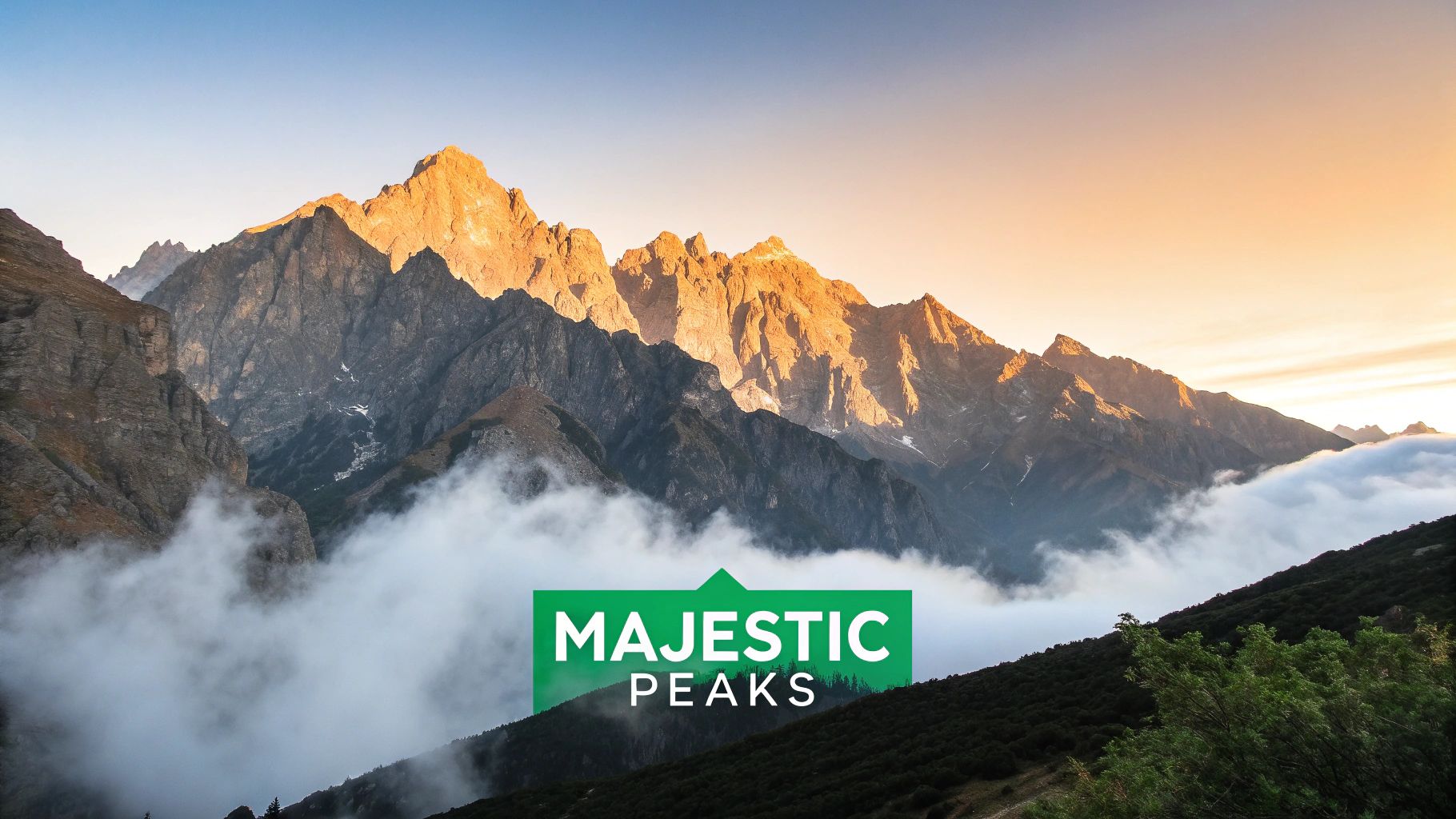
This guide is your ticket to exploring the most significant mountain ranges on Earth. We'll go beyond simple geography to uncover their profound impact on our planet. We'll dig into how these giants are born, the unique life they shelter, and why they are so critical to global ecosystems.
But here’s a twist. When we think of towering peaks, our minds usually jump to the Himalayas or the Andes. Yet, the world's longest mountain range is completely hidden from view. The mid-ocean ridge system is a continuous underwater chain stretching for more than 65,000 kilometers (40,389 miles) across the globe, formed as tectonic plates slowly drift apart. It’s a powerful reminder that some of Earth's greatest wonders lie beneath the waves.
Understanding Our Planet's Peaks
To truly appreciate these natural monuments, you have to understand their scale and origins. They aren't static sculptures; they are dynamic, living environments constantly being shaped by immense geological forces.
We’ll cover the key aspects that make each range unique:
- Geological Origins: How do tectonic collisions, volcanic eruptions, and massive faults in the Earth's crust forge these structures?
- Ecological Significance: Why are they called "water towers" for billions of people and how do they become hotspots for biodiversity?
- Cultural Impact: How have mountain ranges shaped human history, from ancient trade routes to sacred spiritual sites?
Exploring these rugged landscapes yourself requires a special set of skills. If you're planning an adventure, being able to read elevation and contour lines is non-negotiable. Our guide on https://earthchasers.com/blog/how-to-read-topographic-maps will get you started.
From the legendary peaks of the Karakoram to the ancient spine of the Urals, every range tells a story about our planet's past and present. Let's start this journey and gain a deeper appreciation for the majestic mountain ranges of the world.
How Mountains Are Forged by Tectonic Forces
Embedded content
Our planet's surface isn't one solid piece. It’s a massive jigsaw puzzle of enormous, shifting slabs of rock called tectonic plates. These plates float on the semi-molten mantle beneath them, constantly grinding against each other in a geological dance that unfolds over millions of years.
This incredibly slow but powerful process is the main engine behind the creation of the world's most spectacular mountain ranges.
Imagine two cars colliding in ultra-slow motion. When two continental plates slam into each other, the immense pressure forces the rock to buckle, crumple, and thrust upwards—much like the hood of a car in an accident. Geologists call the towering results fold mountains.
This very process is responsible for the mighty Himalayas. The colossal range was born from the Indian Plate crashing into the Eurasian Plate, a collision that started roughly 50 million years ago and continues to this day, pushing the mountains just a little bit higher every year.
The Three Architects of Mountain Building
While continental collisions are the heavy hitters, they aren't the only way mountains are built. The immense energy from tectonic forces expresses itself in three primary ways, each creating a unique type of mountain range: folding, faulting, and volcanic activity.
These three processes are the master architects of our planet’s topography. The infographic below lays out how each path, starting from the same tectonic energy, leads to a completely different kind of mountain.
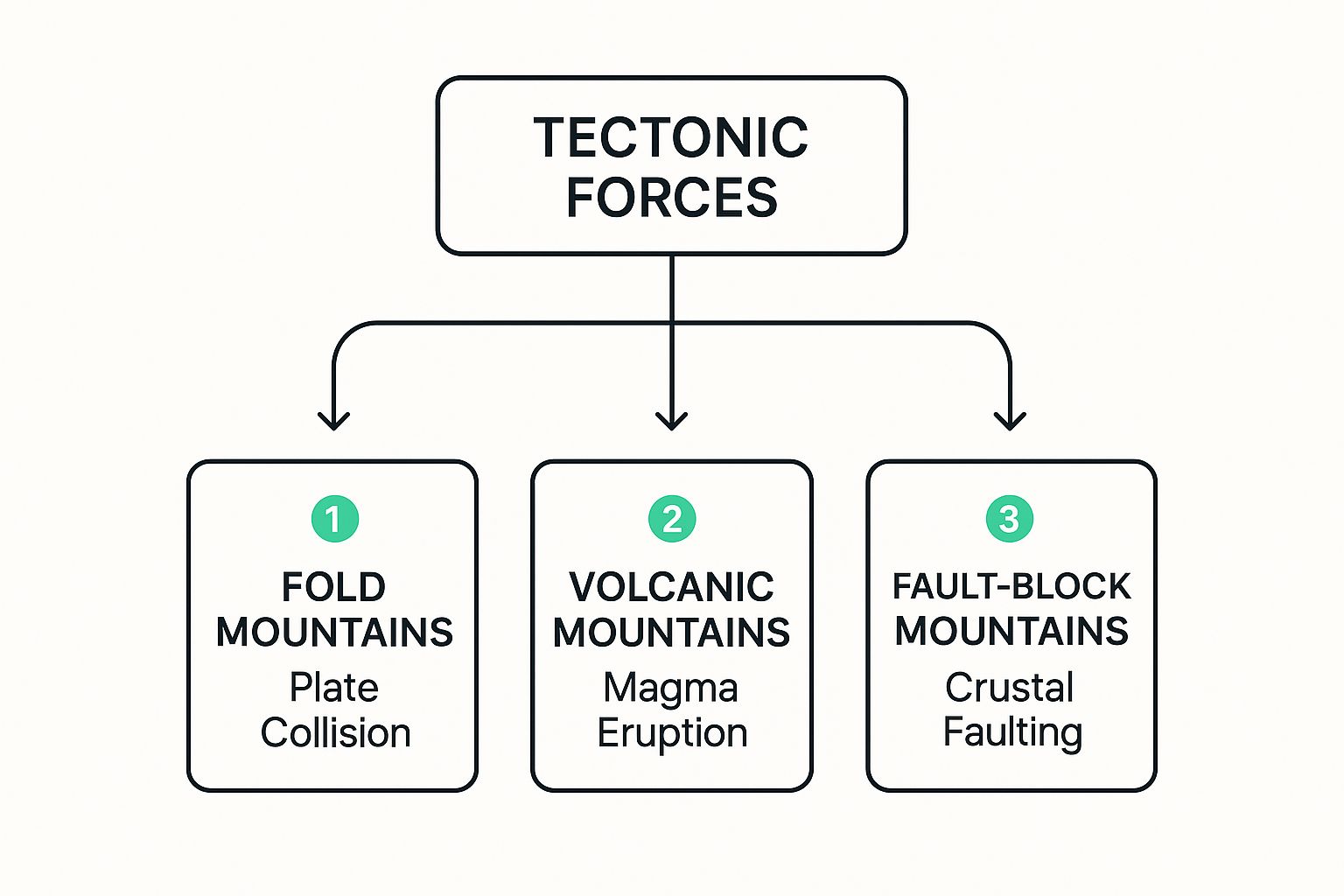
As you can see, the outcome varies wildly—from the crumpled peaks of the Alps to the fiery cones of the Andes.
When Plates Collide and Buckle
As we saw with the Himalayas, fold mountains are the planet’s heavyweights, born from direct plate-on-plate conflict. Squeezed by incredible compression, layers of rock bend and fold without breaking, creating long, parallel ridges and valleys.
You can find stunning examples all over the world:
- The Himalayas (Asia): Home to Mount Everest, this is the world's highest range.
- The Alps (Europe): A classic example of folded rock layers creating jagged, iconic peaks.
- The Andes (South America): Formed as the Nazca Plate dives beneath the South American Plate.
When the Crust Cracks and Shifts
Not all rock can bend under pressure; sometimes, it's just too brittle. When tectonic forces pull the crust apart or shove it together, the rock can fracture along lines called faults. This creates huge blocks of crust that get shoved upward or drop downward, forming what we call fault-block mountains.
Picture a row of books on a shelf. If you push them together from both ends, some might slide up and over the others. That's a great way to visualize how fault-block ranges are made.
The Sierra Nevada in California and the Grand Tetons in Wyoming are postcard-perfect examples of these uplifted blocks, typically featuring one steep, dramatic face and a more gently sloping backside.
Tectonic uplift is a powerful but glacial process. The Teton Range, for instance, has risen more than 7,000 meters (23,000 feet) over the last 10 million years, but relentless erosion has carved away at its peaks, leaving the breathtaking profile we see today.
When Fire Erupts from Below
Finally, some of the most iconic mountains are born from fire. Instead of being built by crumpling or cracking, volcanic mountains are formed by the eruption of magma from deep within the Earth.
As lava, ash, and rock pile up around a volcanic vent, they build up layer by layer, often creating that classic cone shape.
This process is most common along the edges of tectonic plates, especially where one plate sinks beneath another—a subduction zone—melting rock and creating magma. The famous Pacific Ring of Fire is dotted with these fiery giants, including Mount Fuji in Japan and Mount Rainier in the United States. They stand as a powerful reminder of the creative, molten energy just beneath our feet.
A Continental Tour of Towering Giants
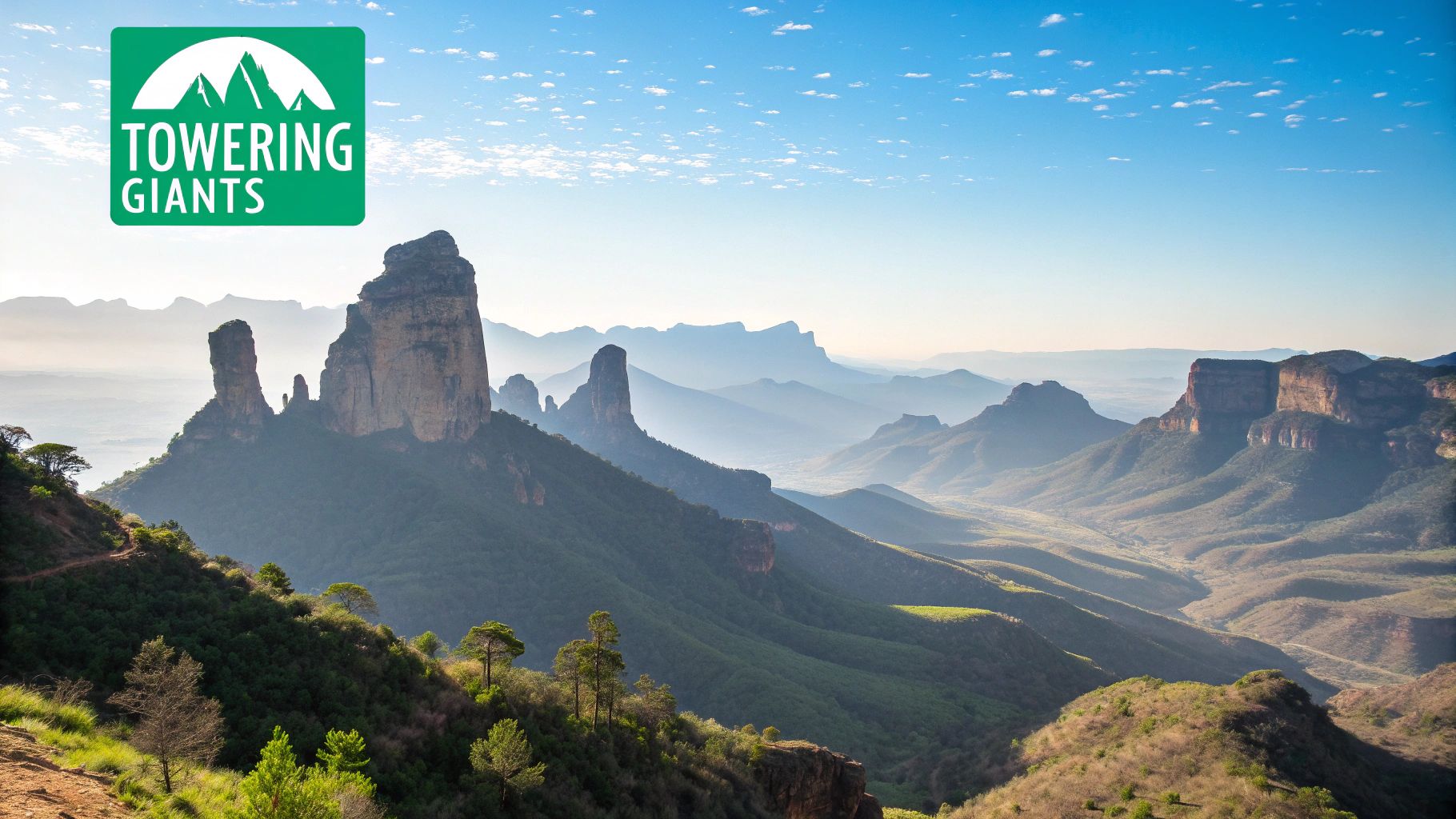
Our global expedition through the major mountain ranges of the world kicks off where the peaks are highest and the legends are oldest: Asia. This isn't just a continent with a few big hills; it's home to Earth’s most formidable mountain systems—colossal structures that dictate weather patterns, cradle ancient cultures, and serve as the source of life-giving water for billions.
Asia: The Land of Giants
We have to start with the most famous of them all: the Himalayas. Often called the "rooftop of the world," this is where you'll find Mount Everest, clawing its way up to 8,848 meters (29,032 feet), the planet's highest point above sea level. Born from the slow-motion, yet unbelievably powerful, collision of the Indian and Eurasian tectonic plates, the Himalayas are geologically young and are, in fact, still growing.
This isn't just some abstract geological fact. The range’s immense height acts as a massive wall, blocking cold, dry air from the north while trapping monsoon moisture to the south. This single feature essentially defines the climate for the entire Indian subcontinent.
Just northwest, you'll find the Karakoram range. Though often overshadowed by its celebrity neighbor, the Karakoram is arguably wilder and more rugged. It boasts the highest concentration of peaks over 8,000 meters anywhere on Earth, including the infamous K2, the world's second-highest mountain.
The Karakoram is also packed with some of the world's longest non-polar glaciers. These frozen rivers feed the Indus River system, making the range a vital water tower for millions in Pakistan and India.
Now, let's head west to meet a much older, more weathered range: the Urals. Stretching roughly 2,500 kilometers (1,550 miles) from the Arctic Ocean down to the Ural River, these mountains form the traditional border between Europe and Asia. Unlike the sharp, jagged peaks of the Himalayas, the Urals are low and worn down—a testament to their ancient origins from a continental collision that happened hundreds of millions of years ago.
For a quick overview of these Asian titans, take a look at the table below.
Comparing Key Mountain Ranges of Asia
This table offers a snapshot comparison of Asia's major mountain ranges, highlighting their highest peaks, lengths, and how they were formed.
| Mountain Range | Highest Peak | Approximate Length (km) | Primary Formation Type |
|---|---|---|---|
| Himalayas | Mount Everest | 2,400 | Tectonic Collision |
| Karakoram | K2 | 500 | Tectonic Collision |
| Ural Mountains | Mount Narodnaya | 2,500 | Ancient Orogeny |
This comparison really drives home the sheer scale and geological diversity found across just one continent.
The Americas: A Continental Spine
Hopping across the Pacific, we trace the longest continental mountain range on the planet—the Andes. This colossal chain snakes its way down the western coast of South America for about 7,000 kilometers (4,350 miles), slicing through seven different countries. The Andes aren't just one long line of peaks; they're a complex web of parallel ranges and high plateaus, all pushed up by the subduction of the Nazca Plate beneath the South American Plate.
This constant geological drama makes the Andes a hotspot for both volcanic eruptions and powerful earthquakes. The incredible changes in elevation also create a stunning variety of ecosystems, from lush tropical rainforests at the base to icy glaciers on the highest peaks.
The Andes were also the cradle of the great Inca Empire. The intricate network of trails and settlements, including the world-famous Machu Picchu, demonstrates a remarkable adaptation to life at extreme altitudes, showcasing a deep connection between culture and mountain geography.
Heading north, we meet the Rocky Mountains, the iconic backbone of North America. Extending more than 4,800 kilometers (3,000 miles) from New Mexico all the way to British Columbia, the Rockies are famous for their dramatic wilderness and stunning national parks like Yellowstone and Banff. Along its crest runs the Continental Divide, a line that separates which ocean the continent's rivers will flow into—east to the Atlantic, west to the Pacific. Using modern tools helps us visualize these complex systems, and you can learn more about what geographic information systems are in our detailed guide.
Europe and Africa: Historic Ranges
Our tour wraps up across the Atlantic, where two ranges have profoundly shaped Western and African history. First, the Alps. Arching across eight European countries, their name is synonymous with classic mountaineering and picture-perfect scenery. Also formed by the collision of the African and Eurasian plates, their jagged peaks like the Matterhorn and Mont Blanc have challenged climbers and inspired artists for centuries.
Finally, our journey concludes in North Africa with the Atlas Mountains. This range stretches across Morocco, Algeria, and Tunisia, acting as a crucial climate barrier. It neatly separates the mild Mediterranean coast from the harsh, arid conditions of the Sahara Desert. As a vital source of water in a dry region, the Atlas Mountains are also home to unique cultures like the Berber people, who have thrived on these slopes for thousands of years. Each range tells its own epic story of our planet's power.
Life in the Shadows of the Americas' Spine
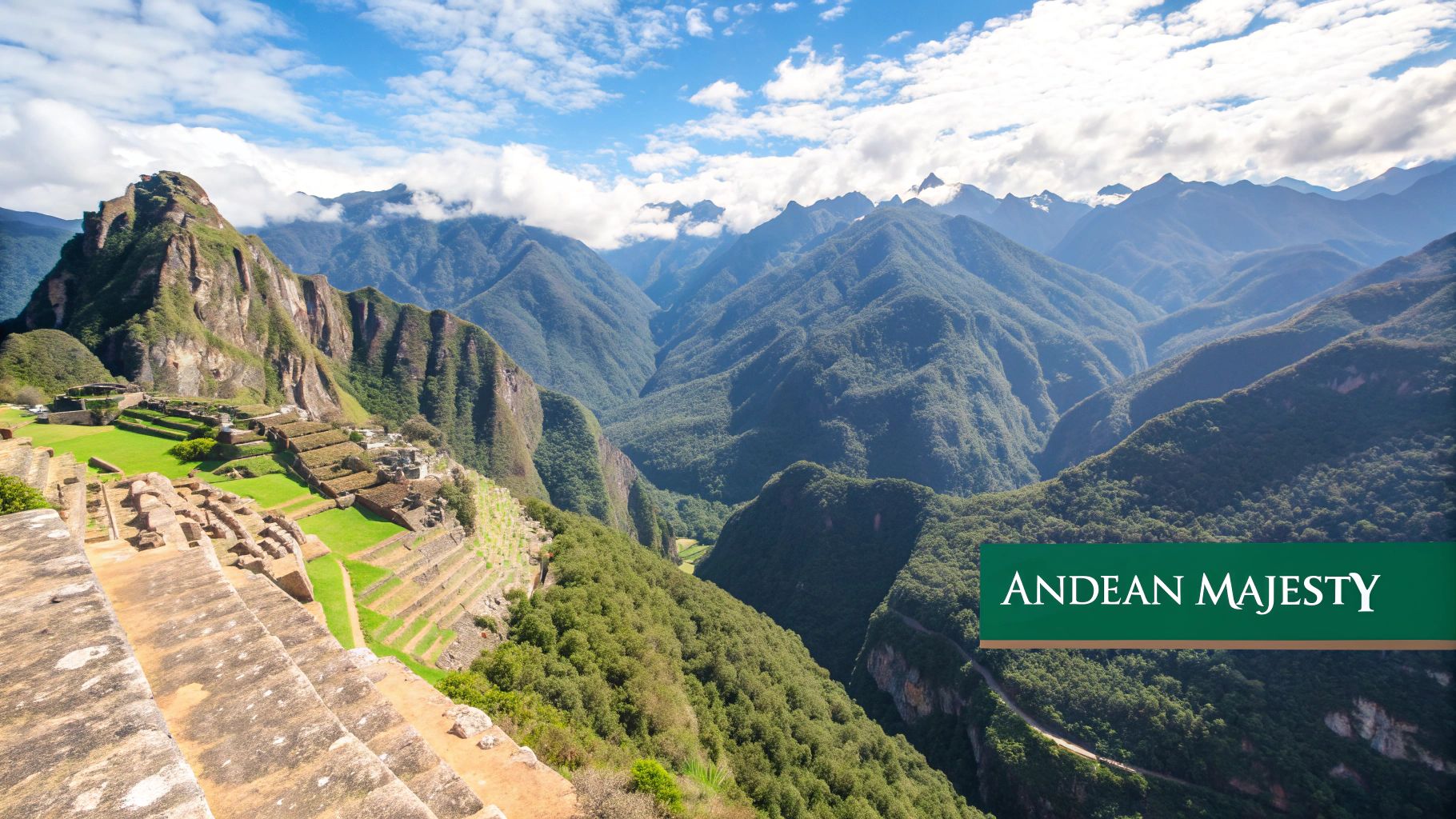
If you trace your finger down a map of the Western Hemisphere, you’ll follow a colossal backbone of mountains that defines two entire continents. These ranges aren't just lines of rock; they are the arteries of the landscape, dictating everything from where rivers flow to the very course of human history.
Our journey continues along this incredible spine, exploring two of its most iconic sections: the Andes and the Rocky Mountains.
The Andes: A World of Extremes
Let’s start in South America with the Andes, a range of superlatives. As one of the planet's most dynamic mountain ranges of the world, its volcanic heart is in constant motion, shaping the land with eruptions and tremors. This raw geological power comes from the Nazca Plate diving beneath the South American Plate, a process that has been relentlessly pushing these peaks skyward for millions of years.
But the Andes are so much more than a geological spectacle. They were the cradle of advanced civilizations, most famously the Inca Empire. High on an Andean ridge, the breathtaking ruins of Machu Picchu stand as a testament to their ability to not just survive but thrive in one of the world's most challenging high-altitude environments.
The sheer scale of the Andes is hard to wrap your head around. It is, by a huge margin, the longest continental mountain range on Earth, stretching thousands of kilometers along the western edge of South America. This massive chain cuts through seven different countries, from the Caribbean coast of Venezuela all the way down to the icy tip of Patagonia.
This incredible length packs a stunning variety of climates and ecosystems into a single range. You'll find tropical glaciers near the equator, some of the world's driest deserts sitting in its rain shadow, and misty cloud forests clinging to its slopes.
This diversity of habitats has led to an explosion of life. The Andes are home to over 30,000 plant species and thousands of animal species, many of which you can't find anywhere else on the planet. Think of the majestic Andean condor soaring on thermal updrafts, or the elusive spectacled bear, South America's only native bear. If you want to dive deeper into its record-breaking statistics, you can explore more facts about the world's longest mountain ranges.
The Rocky Mountains: A Symbol of Wilderness
Now let's head north to the Rocky Mountains, an equally iconic but very different kind of range. Where the Andes are fiery and tropical, the Rockies are the rugged, untamed heart of North American wilderness. Their granite peaks and vast forests have become a powerful symbol of exploration and raw natural beauty.
Stretching from New Mexico all the way up through Canada, the Rockies are a complex patchwork of smaller ranges and basins. They're older and geologically quieter than the Andes, shaped less by active volcanoes and more by the grinding power of ancient glaciers. It was this glacial carving that sculpted the dramatic U-shaped valleys and razor-sharp peaks that define places like Glacier National Park.
One of the coolest features of the Rockies is the Continental Divide. This hydrological apex runs along its highest peaks and acts like the roof of the continent. Any rain or snow that falls on the eastern side will eventually drain into the Atlantic Ocean, while everything on the western side makes its way to the Pacific.
A Legacy of Conservation
The awe-inspiring landscapes of the Rockies played a huge part in the birth of the conservation movement in North America. The desire to protect these pristine wilderness areas led to the creation of some of the world's first and most famous national parks.
- Yellowstone National Park: The world's very first national park, set aside to protect a wild geothermal landscape and huge wildlife populations.
- Banff National Park: Canada's first national park, famous for its postcard-perfect turquoise glacial lakes and stunning mountain scenery.
- Grand Teton National Park: Known for its dramatic, jagged peaks that rocket straight up from the valley floor without any foothills.
Today, these parks are vital refuges for iconic North American wildlife like grizzly bears, wolves, elk, and bison. They are living laboratories for ecological research and give millions of visitors a chance to connect with a truly untamed world. Both the Andes and the Rockies stand as powerful testaments to how mountains shape not just the land, but life itself.
Why Mountain Ranges Matter for the Planet
It’s easy to see the great mountain ranges of the world as just stunning backdrops or challenges for climbers. But beyond their raw beauty, they are massive, silent engines that keep our planet’s systems humming. They are absolutely essential, regulating climate, nurturing life, and supplying vital resources to billions of us living hundreds of miles away.
Think of them as the planet’s natural water towers. As weather systems move across the land, high-altitude peaks snag incredible amounts of moisture from the air, locking it away as snow and ice. This frozen reservoir doesn't just stay there; it melts slowly and steadily, feeding the headwaters of the world's most critical rivers—like the Indus, Ganges, and Yangtze. This process delivers a reliable supply of fresh water for drinking, farming, and industry to more than half the global population.
Hotspots of Life and Climate Control
Mountains are also powerful players in shaping global weather patterns. Their sheer height creates a physical wall that blocks and redirects air masses, forcing them to rise, cool, and release their moisture. This is what creates the famous "rain shadow effect," leaving one side of a range lush and green while the other is often arid and dry. The result is a dramatic influence on regional climates and the creation of vastly different habitats in close proximity.
This incredible variation in elevation, temperature, and moisture turns mountain ranges into bustling biodiversity hotspots.
- Vertical Ecosystems: On a single mountain slope, you can travel through multiple life zones, almost like journeying from a temperate forest to the arctic tundra in just a few miles.
- Evolutionary Cradles: The isolated nature of mountain valleys gives evolution a chance to get creative. Unique species of plants and animals emerge here, perfectly adapted to their secluded homes and found nowhere else on Earth.
These high-altitude environments are basically islands in the sky, each one a unique cradle for life. You can see how these specialized ecosystems fit into the global puzzle by exploring the different biomes of the world in our guide.
Cultural and Spiritual Anchors
For as long as humans have been around, we've looked to mountains with a sense of awe and reverence. Their towering presence has inspired stories, art, and faith in countless cultures. They are often seen as sacred spaces—the homes of gods, the destination for spiritual pilgrimages, or the ultimate symbol of strength and endurance.
From the sacred Mount Kailash in the Himalayas to the revered Mount Fuji in Japan, mountains are not just geological features; they are woven into the very fabric of human identity and spirituality, reminding us of our connection to the natural world.
When you get right down to it, these majestic landforms are so much more than scenery. They are active, vital cogs in Earth’s machinery, connecting our atmosphere, water, and life in a way that sustains all of us.
Common Questions About Mountain Ranges
Even after digging into the geology and geography of the world's great mountain ranges, a few questions tend to linger. Let's tackle some of the most common ones to clear up any final curiosities.
What’s the Difference Between a Mountain and a Mountain Range?
It all comes down to scale. Think of a mountain as a single, standalone peak that juts up from the surrounding landscape—like Mount Rainier in Washington. It's the individual.
A mountain range, on the other hand, is a whole family of mountains. It’s a long chain of peaks that are all connected, usually formed by the same geological event. Mount Everest might be the most famous individual, but it’s just one part of the colossal Himalayan mountain range.
Are New Mountain Ranges Still Being Formed Today?
Absolutely. The Earth’s crust is in constant, albeit incredibly slow, motion. That means mountain-building is a process that never really stops. Plate tectonics are always at work, endlessly crumpling and pushing up the planet's surface.
The Himalayas are the perfect live example. The Indian Plate is still relentlessly shoving its way into the Eurasian Plate, which forces the entire range to grow taller by a few millimeters every single year. You can also see it happening on the ocean floor, where underwater volcanoes along the Mid-Ocean Ridge are constantly creating new mountainous terrain.
How Do Mountain Ranges Affect the Weather?
Mountain ranges are massive weather-makers, mostly because of something called the rain shadow effect. When a big mass of moist air blows in from the ocean and hits a mountain range, it has nowhere to go but up.
As the air rises, it cools, and that causes all the moisture to condense and fall as rain or snow. This douses the windward side of the range (the side facing the wind), creating lush, green landscapes.
But by the time the air crests the peaks and starts heading down the other side—the leeward side—it’s lost most of its moisture. This dry air then sinks and warms up, creating arid, desert-like conditions. It’s no coincidence that the Gobi Desert sits in the massive rain shadow cast by the Himalayas.
Ready to see these majestic landscapes in a whole new way? EarthChasers brings the world's geography to life through an interactive 3D game. You can discover towering peaks, ancient cities, and natural wonders on your own global adventure. Test your knowledge, climb the leaderboards, and see the planet like never before at https://earthchasers.com.
